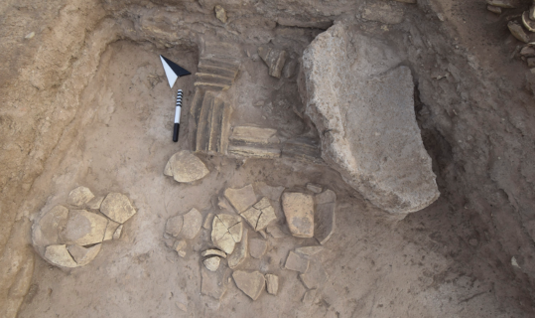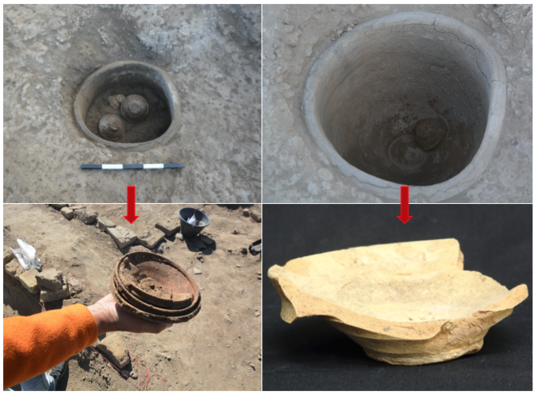UR Pottery
Ur III- and Old Babylonian Pottery from Ur
DFG-Project, 2021-2023
Project Director: Prof. Dr. Adelheid Otto
Research Fellows: Dr. des. Albert Dietz and Johannes Hechtl, MA
Project Description
The objective of this project is to work the pottery from Ur III- and Old Babylonian levels from areal 5 at Ur. The pottery was unearthed during the LMU excavations at Ur in 2017 and 2019, in the course of which the finds and records were excavated and documented in detail. The excavations conducted by Sir Leonard Woolley at Ur (1922-1934) were relevant for the understanding of the Ancient Near East in many ways, however not with respect to pottery. With the help of our material it will be possible for the first time ever to make a detailled evaluation of Old Babylonian und Ur III pottery from Ur by means of ceramic seriation. The Old Babylonian pottery originates from well dated contexts in a residential house with three successive phases of use, the Ur III pottery from the the storage and farm buildings underneath. Statistical evaluations will allow a detailled analysis of the development of pottery forms. Furthermore, this project will yield not only fix points for Ur pottery, but also reliable data for Babylonian pottery in general during the individual periods.
The House of Sîn-nādā:
One single house was recorded for level 4, most walls of which were directly on the surface. The house measures 230 sqm and consists of 16 rooms grouped around a yard, and exhibits four phases of structural alterations in the form of bricked-up or broken-through doors and changed fittings. Phases 1 and 2 date back to the Isin-Larsa period, phases 3 and 4 are Old Babylonian. During the phases 1 and 2 the house was inhabited by the director of the Ningal temple Sîn-nādā and his wife Nuṭṭuptum. The dating can be concluded from dated clay tablets and seal impressions mentioning kings' names.
The house was abandoned abruptly in 1835. Worthless objects such as pottery or damaged objects (equipment, figurines, clay tablets, seal impressions) were either left behind in the rooms (figs. 1b-d) or thrown onto a huge waste heap in room 5 (fig 1a). We can conclude the exact dating of this incisive event from the latest clay tablets dating back to the kings Sîn-iqîšam Jahr 5 (1836) and Ṣilli-Adad (1835), as well as from seal impressions of the proprietor Sîn-nādā, who was obviously using two seals at the same time. On one of them he refers to himself as servant of Sîn-eribam (1842-1840), on the other one as servant of Ṣilli-Adad (1835). This gives us the precise year when the house was abandoned and an exact terminus ante quem for the entire material - including pottery - collected in this level, a unique lucky circumstance for the dating of early Old Babylonian / Isin-Larsa material.

- fig. 1a: Thrown-away pottery, mixed with dated seal impresssions and clay tablets on the waste heap in room 5, level 4, phase 2.
- fig. 1b: Painted bowl from room 8, level 4, phase 2.
- fig. 1c: Pottery on the floor of room 8, level 4, phase 2.
- fig. 1d: Two fragmented bowls next to the letter of Sîn-nādā to his wife Nuṭṭuptum (arrow) on the floor of room 13, level 4, phase 2.
During phase 3, the house was again used for residential and working purposes. Judging from the numerous alterations to the house, the proprietor had changed. Also phase 3 seems to have been abandoned fairly abruptly: also here, complete or broken complete vessels had remained on the floor. (fig. 2).

fig. 2: Broken vessels on the floor of room 9 next to a grinding device from basalt, level 4, phase 3.
The Ur III Level

fig. 3: Open space (above) with shard pavement and a gadget (red square, detail left below)
as well as other in-situ pottery (yellow square, detail right below)
and a large in-ground vessel (blue circle, see also fig 4).
The above-described „House of Sîn-nādā“ from level 4 was directly built onto the Ur III level. The excavated Ur III area is located south of the Sîn-nādā house, and does not reveal any Isin-Larsa constructions. This area, however, was no residential house, but an open space surrounded by rooms at three sides at the least (fig. 3 above). The rooms at the eastern side of the place reveal their function: they seem to have been storage rooms or granaries, which might correlate with the central Ur III administration. The material on the surveyed place - both the pottery and devices as well as an in-ground large vessel containing an Ur III set of bowls (fig. 3 blue circle, fig. 4) - indicate that this area may have been used for the delivery, registration, measuring and weighing, and processing of grain.

fig. 4: An in-ground vessel with a set of three bowls (left)
and another bowl that can be assigned to the Ur III-period, at the bottom of the vessel (right).
Further Information
On the excavations at Ur: https://www.vorderas-archaeologie.uni-muenchen.de/forschung/ur/index.html
Contact
- Prof. Dr. Adelheid Otto: aotto@lmu.de
- Dr. des. Albert Dietz: Albert.Dietz@lmu.de

